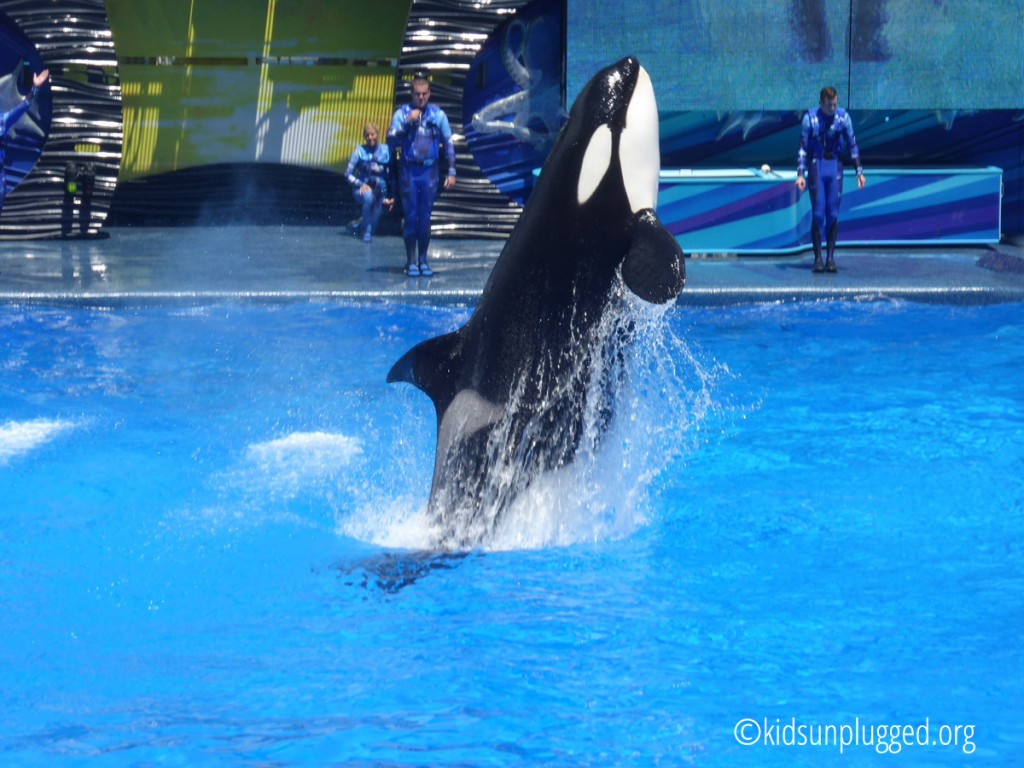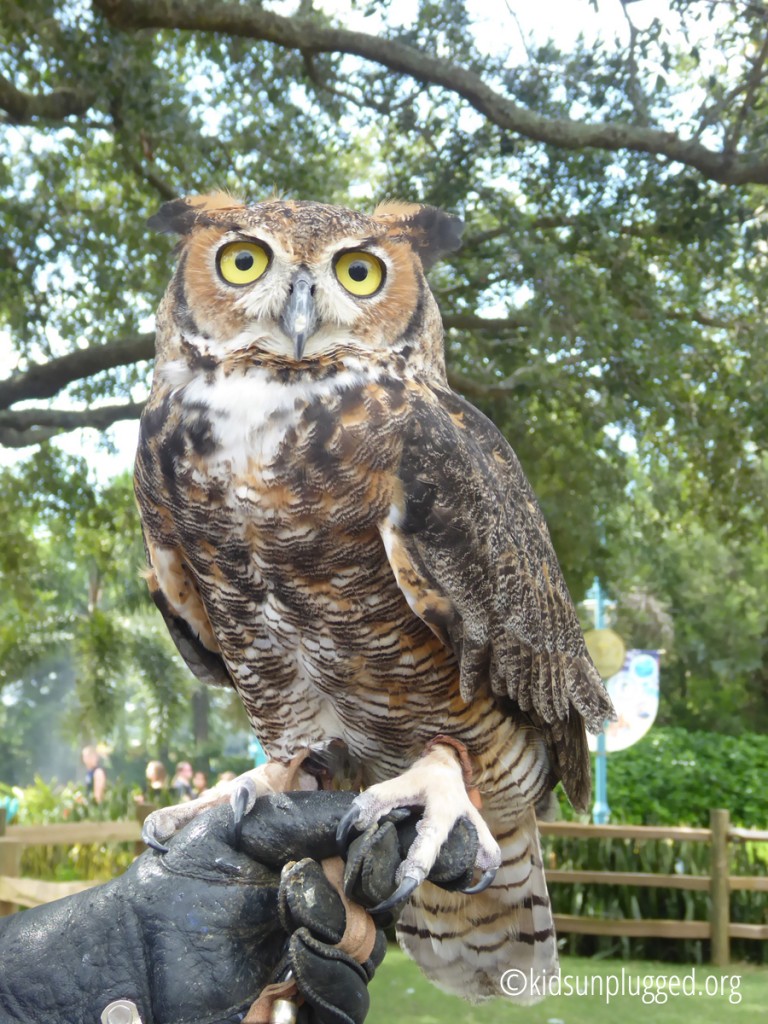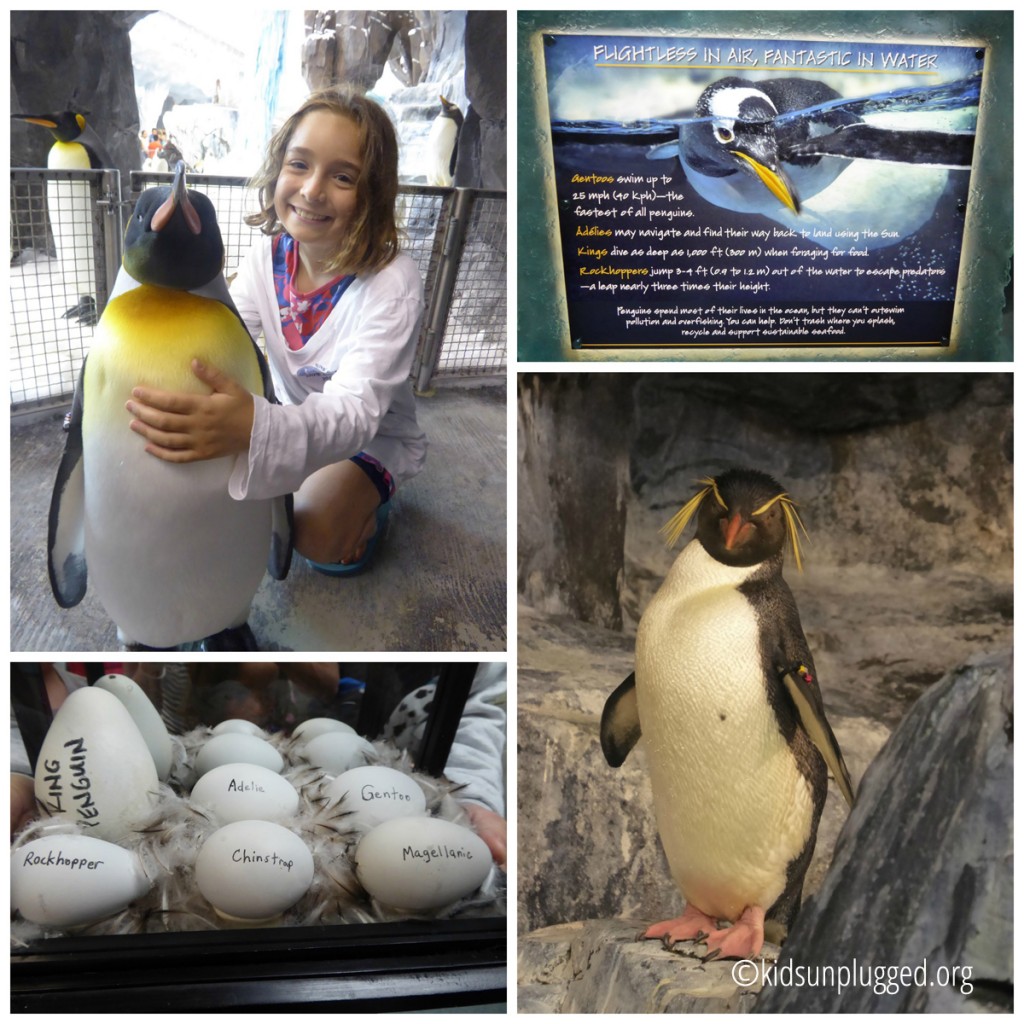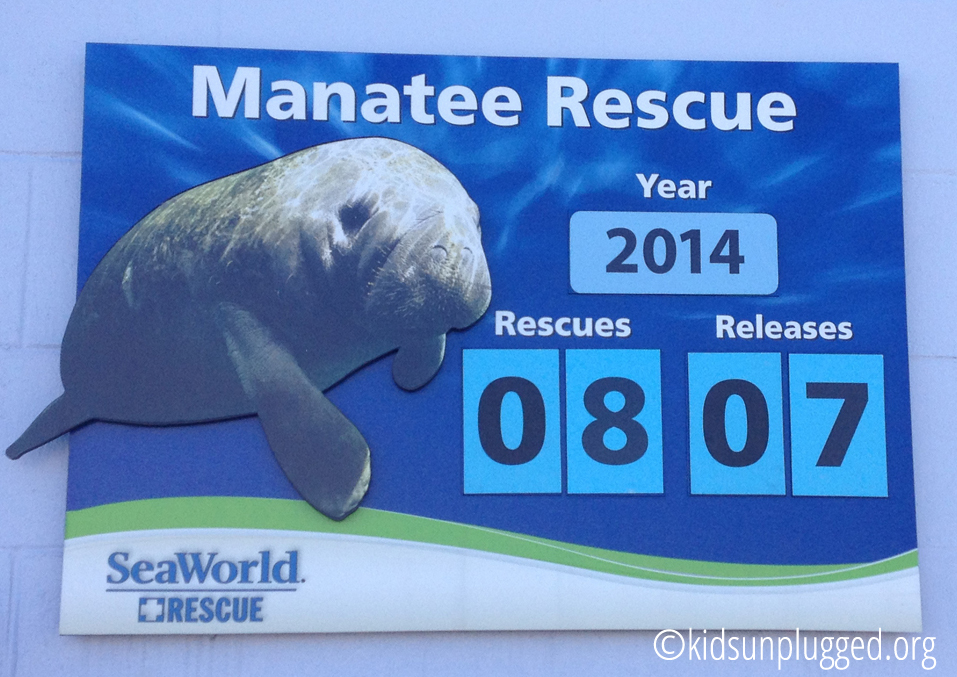
This summer I spent a day visiting SeaWorld in Orlando, Florida with my youngest daughter as part of a bloggers’ familiarization trip. I had some serious misgivings about the trip at first given the controversy surrounding SeaWorld caused by the Blackfish documentary. An exposé of sorts, Blackfish examines the death of orca head trainer Dawn Brancheau in 2010 and explores the psychological impact of captivity on orcas and their temperaments. Since its airing on CNN in October 2013, the film has reached millions of viewers and has inspired numerous anti-captivity campaigns to form online and in social media.
 When the opportunity to visit SeaWorld was presented to me, I was hesitant to potentially align myself with a company whose ethics were under so much public fire. Still, SeaWorld is also well known for its innovation and research in the field of marine biology and its efforts in animal rescue and rehabilitation. I watched Blackfish the day before the trip so that I’d have that information as part of my lens during my visit. At this point, although I was headed to Orlando prepared to be upset by what I would see, I was nevertheless open-minded.
When the opportunity to visit SeaWorld was presented to me, I was hesitant to potentially align myself with a company whose ethics were under so much public fire. Still, SeaWorld is also well known for its innovation and research in the field of marine biology and its efforts in animal rescue and rehabilitation. I watched Blackfish the day before the trip so that I’d have that information as part of my lens during my visit. At this point, although I was headed to Orlando prepared to be upset by what I would see, I was nevertheless open-minded.
I am particular about the places I write about and seek those that allow people to step away from the busyness of everyday life and the pull of electronics to enjoy nature, the outdoors, the arts and one another. I’m not anxious to participate in press trips for the sake of a free vacation or to learn about destinations I wouldn’t choose to visit with my own family.
That said I also didn’t want to simply get sucked into the Blackfish drama. I wanted to see first hand what SeaWorld was doing for their animals and in the interest of conservation on a whole. I’d never been to any of the SeaWorld parks before and needed to determine for myself where I stood.

As parents, we don’t have an aversion to visiting zoos and aquariums in general. Our family has had memberships at New York’s Bronx Zoo and the Norwalk Aquarium in Connecticut since our girls were toddlers and we spend plenty of time at our local nature centers. We also do what we can to view animals in their natural habitats when doing anything from hiking through the smallest nature preserves to camping in the largest national parks. Spotting black bears in the Shenandoah forest, searching for moose on the labyrinthine logging roads of northwestern Maine, floating above sea turtles as they munched on grasses in the waters of St. John, or a spying a bald eagle perched high in a tree on the shore of a Vermont Lake are some of our favorite vacation memories.
 But these are isolated encounters. Because our travel budget is limited, the opportunities we have to see animals in the wild is also limited and most families find themselves in a similar situation. While we hope to one day take our girls on safari in Africa or trekking through the rain forest in Costa Rica, right now our only exposure to animals living in more exotic environments are those in captivity. But what types of environments of captivity was I comfortable visiting with my kids? Was SeaWorld going to make it onto that list?
But these are isolated encounters. Because our travel budget is limited, the opportunities we have to see animals in the wild is also limited and most families find themselves in a similar situation. While we hope to one day take our girls on safari in Africa or trekking through the rain forest in Costa Rica, right now our only exposure to animals living in more exotic environments are those in captivity. But what types of environments of captivity was I comfortable visiting with my kids? Was SeaWorld going to make it onto that list?
The day we spent at SeaWorld was packed with animal interactions, trainer interviews, and tours of non-public animal habitats and research areas. After arriving at the park, we met Animal Care Specialist Brandt Gabriel who explained the work SeaWorld does in conjunction with Florida Fish and Wildlife and other organizations and watched as a 6-week old rescued manatee had her bottle.
We visited the Turtle Trek exhibit where we learned about some of the habits we can all adopt as “Everyday Heroes” that would make a difference in the lives of threatened and endangered sea turtles. We stopped by the Sea Garden section of the park where we saw some incredible sculptures made entirely of marine debris by the Oregon-based Washed Ashore Project and met a baby sloth that had recently been found abandoned in Panama.
We learned about the breeding practices of the 4 species of penguins who make SeaWorld their home from two of the park’s aviculturalists. And yes, we saw the One Ocean show in Shamu Stadium featuring SeaWorld’s famed killer whales after which we had the opportunity hear from and speak with a few of the whales’ trainers.

My takeaway from our visit to SeaWorld is that the powers that be are not simply in it for the profit. I left the park thoroughly surprised by what I saw and impressed by the integrity of the staff we met, especially Kat and Kaylin with whom I engaged in some hearty discussion throughout the day. Almost everyone I spoke to shared a similar sentiment, “I wouldn’t be here if I didn’t believe in the good that SeaWorld is doing for its animals,” was the common thread. Could you argue that SeaWorld’s staff was simply feeding me a sound-byte and towing the party line? Sure. But I have faith in humanity and choose to trust that these folks do care deeply about their work at SeaWorld, about the protection of the animals they tend, and for animal conservation on the whole.

So should you take your kids to visit SeaWorld? That’s a decision you need to make for yourself. The issue of keeping orcas in captivity—or any animals, for that matter—is complicated and multifaceted and isn’t going to be solved in this post. My decision to participate in this trip and our subsequent visit to the park opened up lots of discussion in our family—about the message of Blackfish, about animal welfare and conservation, about the benefits and disadvantages of animals living in zoos and aquariums, about the roles of not-for-profits and corporate entities and about observing captive animals for education versus entertainment. The more open we are with our kids about the questions we grapple with and the more we welcome the questions they have, the more they learn to think for themselves and the more everyone will benefit.
Disclosure: I was invited to visit SeaWorld to learn more about their conservation efforts, animal rescue and rehabilitation programs, and innovations in the care of marine mammals. As always, all of the opinions in this post are my own.

Thanks for sharing your honest thoughts from your visit. I honestly believe there is more good than harm there. I haven’t seen Blackfish and don’t plan too. There’s something about those independent films that tends to turn me off. I think the best way to form an opinion of your own is to actually be there. We plan to visit this coming February.
Thanks for your comment, Heidi! Blackfish was upsetting to watch and I felt that I needed to see it before this trip in order to have both perspectives in mind to make a sound judgement. I look forward to hearing your thoughts after your visit this winter.
Lovely honest article
As a SeaWorld,fan from England for 19 years now I was pleased you saw the park in its honest open truth of conservation and connections and education
No one else has done more for our oceans than SeaWorld and the enduring memories I have of SeaWorld you described superbly
A team of honest dedicated people caring deeply for their animals and relishing the opportunity to entertain educate and discuss their work
I find the place remarkable and a jewel in the crown of American culture,,,I agree the initial slavery of whales back in the 1970s was scandalous but that’s all finished now all SeaWorld do now is care for their animals none are captured and they breed their own whales dolphins etc now
Thank you for your article it’s given me delight reading and so good to see that this propaganda programme blackfish is made by activists who do nothing for animal welfare nothing for animal conservation all it is is greed to make money of the death of a truly wonderful lady in dawn….she was inspirational so kind so open and honest,,,we miss her
Thanks agin
What a thoughtful article. So glad you went in with an open but questioning mind. I’m conflicted about Sea World as well – we’ve been and my daughter enjoyed it (and I loved it as a child myself), but I don’t know what the right answer is for the future.
Leslie, I appreciate your feedback–it was a tough piece to write. I have some apprehensions about the orca program at SeaWorld, especially in terms of breeding the animals. The whole experience has really made me want to explore the role of zoos and aquariums more deeply. I’m totally in favor of education and conservation and I think there is a fine line between education and entertainment. This is definitely a discussion to be continued!
I really enjoyed your perspective and comments. I’ve visited SeaWorld and watched Blackfish. Blackfish is definitely emotional and can make you pretty upset, but after thinking about it, you realize there aren’t many facts or proof to the comments. After seeing SeaWorld in action – not only the amazing things they do for the environment and for animals but also how they inspire humans to be more interested in animals and caring for the world.
Thanks for reading and for your comment, Clay. Yes, Blackfish does elicit a very emotional response. I was glad to see all the good that is happening at SeaWorld in the midst of the orca controversy–it wouldn’t be fair to overlook that because of the negative press generated by the film.
I’m glad you took the trip. Even given my current feelings about SeaWorld, I would still have gone to have the opportunity to see the other side of the coin. Also, as a longtime SeaWorld fan, I know that they are more than their orcas.
I visited in 2011 in San Diego and was so excited to take my son. He fell in love with the place and with Shamu. For me, I was disheartened to see that it had become more of an amusement park than an animal conservation park. I hope that they continue to focus on animal conservation and education and take more of the “show” out of the animal shows (and that they find that people will still support that).
Thanks for your great post. Is that a real penguin that your daughter is posing with??
Fadra, I haven’t been to the San Diego SeaWorld but was surprised by the fact that the park felt more like a high-quality aquarium than a theme park (I mention that here in my review on Traveling Mom here: http://www.travelingmom.com/5-conservation-tenets-at-seaworld-orlando/). I was also surprised by how much I enjoyed our day there. My daughter loved it and we’d had plenty of conversation about the tough issues prior to our trip. And yes, that IS a real penguin. I never knew penguins were so soft–he was very sweet. I think the penguins and the time we spent with the aviculturalists in their habitat were a highlight for me. Thanks so much for your comment!
Very thoughtful article. I too have seen Blackfish, but have also been to SeaWorld a half dozen times. I didn’t go into Blackfish with no prior knowledge though, but I did watch it with an open mind. I spotted the blatant lies and half truths right away as I was watching it. I have done a lot of reading over the years and talked to passionate people on both sides of the coin and those who are neutral, seeing the good and the bad. I’ve loved orcas my entire life and as a child dreamed of joining SeaWorld’s dedicated team of trainers working with them. I did a lot of research to make sure they did take good care of their animals and learned just how passionate the staff there are. As trainers have said, why would they work for a company that’s guilty of everything Blackfish says? They wouldn’t. The truth is in their parks and staff.
The cetacean captivity debate is much, much older than Blackfish, going as far back as the very beginning of US dolphinariums in the 1960s. The animal rights activists arguments were just as emotionally charged and anthropomorphizing then as they are now. The thing is, it takes someone truly level headed who went into the movie with little prior knowledge to not be immediately sucked in to their argument. That’s how the production crew wanted it. Many of my Facebook friends have now vowed to boycott SeaWorld after seeing this movie, with their rallying cry being a hashtag that says “emptythetanks”. Sadly, it seems many of these people (including the production crew) hate SeaWorld more than they love killer whales.
Sorry this turned out so long. I’m quite passionate in my support of SeaWorld as you can see haha. There are many websites and blogs that to through the movie step by step, exposing the half truths and, in some cases, blatant lies, while still allowing the reader to come to his or her own conclusion. That’s what real, objective research is all about.
Kira, Thanks so much for your comment. I spent a lot of time reading about these issues both prior to the trip and upon my return. Along with the NY Mag article I link to in my post, I really enjoyed the Quest for SeaWorld series created by Voices of San Diego (http://voiceofsandiego.org/2014/03/28/why-some-seaworld-opponents-still-love-the-zoo/). I know that the Blackfish film has taken a lot of heat as being biased and offering the perspectives of only a few of SeaWorld’s former trainers. I don’t know what to think about its accuracy. I agree that the cetacean debate has been going on for a long time and I do have a hard time with the “shows” and the entertainment vs. education argument. As I said in my post, this is not something that I’m going to solve in this one piece and I will surely continue to grapple with these issues in the future.
I try to keep an open mind and not buy what either side says without checking it out for myself. My daughter had been asking to go to SeaWorld, so as an animal lover, I wanted to make sure I wasn’t supporting animal abuse. The more I researched, the more I realized just how much SeaWorld does, not only for their animals, but for those in the wild. I took my family in April and any doubt I had left about the welfare of the animals went away. One thing that struck me was the relationship these trainers have with the whales. It’s obvious how much they love them. I see all this talk about them being in bathtubs and having to do tricks for their food or be starved and I just shake my head. I can understand being against captivity. That is one thing, but there’s no need to blatantly lie in an attempt to hurt SeaWorld. The fact is, without SeaWorld, all the animals they rescue would be dead. To anybody who is against SeaWorld because of Blackfish, I would say go and see the animals for yourself and do your own research before jumping on the Blackfish wagon.
Allison, I felt the same way about what I saw in the interactions between the trainers and the whales and I do believe that the trainers are very passionate about what they do and for the animal with whom they work. I do worry about the effects on the orcas living in captivity–especially the dynamic between the whales who are together. I wish SeaWorld did more to create pods that more closely reflect the way orcas live in the wild. That said, the reason I wrote this piece was not to rehash the orca debate but to consider the good things SeaWorld is doing in the midst of that debate.
This was a great article, my concern that I had when we visited was that the tanks were too small for some of the mammals They had 6 dolphins in an area the size of my swimming pool.. I love the fact that they are rescuing and breading,. I’m not sure if they still have there show with Clyde but that bothered me as I am against animals of any kind for entertainment.
Donna, thanks for reading. I believe the Clyde show has ended though I think it will be replaced by something new in the future. I did not visit the dolphin habitat but did have the chance to observe some dolphins that had been rescued in the park’s North Support animal rescue area. I wrote a more detailed piece about the actions SeaWorld is taking toward conservation here: http://www.travelingmom.com/5-conservation-tenets-at-seaworld-orlando/
I visited SeaWorld for over 25 years – before moving to Orlando and working in the Park as a photographer. I have watched their mission grow stronger toward interraction rather than just performances. I think some good came out of the Blackfish movie. Just to prove SeaWorld is reputable – they made changes for the better. Over all, the Blackfish movie is slanted toward the negative. I am grateful my kids got to see whales, dolphins and penguins – something they would never have seen otherwise.
Jan, your comment, ” I am grateful my kids got to see whales, dolphins and penguins – something they would never have seen otherwise,” touches on a major issue–what precisely is the role of zoos and aquariums? How are the animals in the wild benefitted from their counterparts in captivity? I’m not sure of the answer, though the idea of keeping larger, more intelligent animals in captivity, not just marine mammals but elephants and primates as well, is one that I think will be evaluated and reevaluated quite a bit in the coming years.
Thank you for your thoughtful post. I have posted some comments on my blog about this subject, but as an industry “insider” I am probably considered biased. Folks like you (and many of your followers, judging by the responses) can do enormous good for animals if you will continue to evaluate zoos and aquariums fairly and with your own observations, and not based on media reports with an agenda. Here is my latest post on the subject: http://jdporterbooks.blogspot.com/2014/09/seaworld-is-it-worthy-of-rescue.html
Doug, I appreciate your comment and thank you for sharing the link to your site. I read your great piece and am fascinated by what you’re doing. I look forward to your new book and will continue to read your blog!
So nice to find someone who finds their own truth instead of being a follower on either side! I loved your honesty, thanks for sharing!
Thanks for the kind words, Heather!
Gina, it’s important to understand that the rescue/rehabilitation efforts that SeaWorld participates in are a completely separate issue from the practice of keeping and breeding killer whales in captivity. SeaWorld rescue should be commended but it doesn’t take away from the fact that it is completely unethical to keep killer whales in captivity. Turtle Trek is incredibly educational, but it is also the only true education that you are given at the park. All other “educational facts” have been altered to validate captivity. Please keep that in mind when considering future trips to SeaWorld or any other zoological institution.